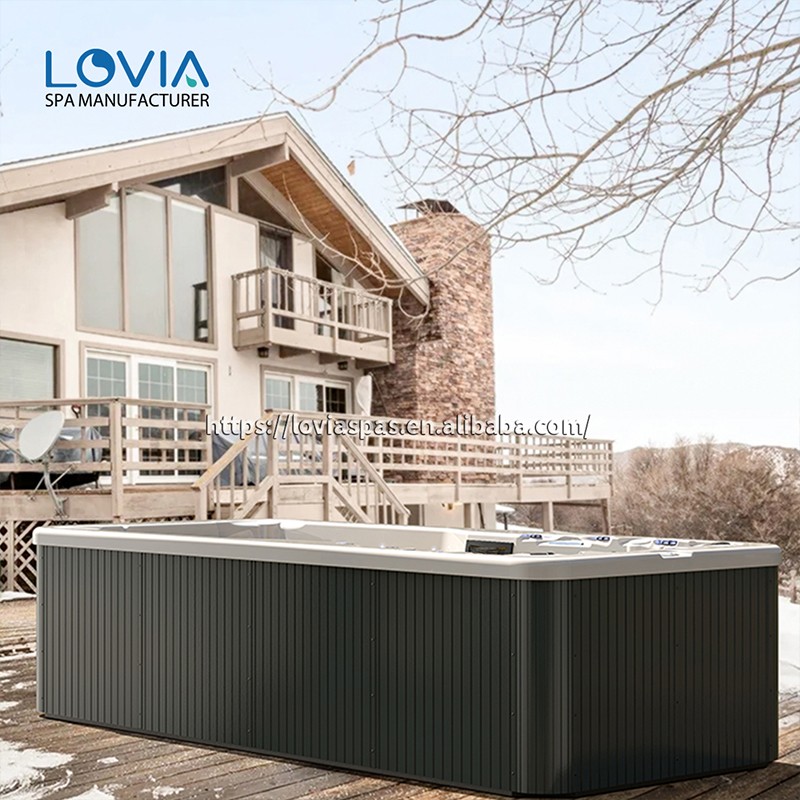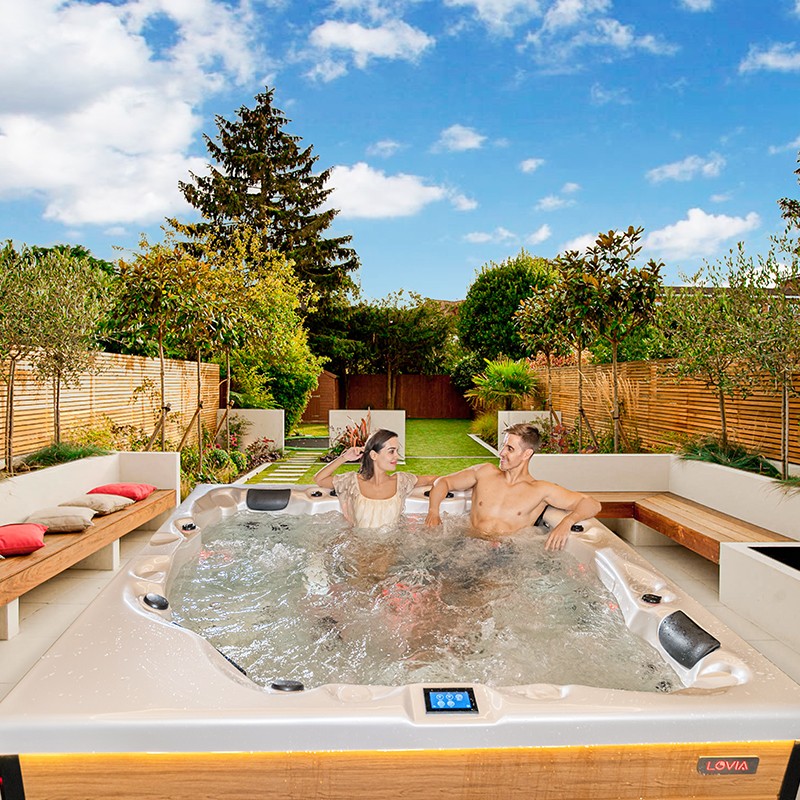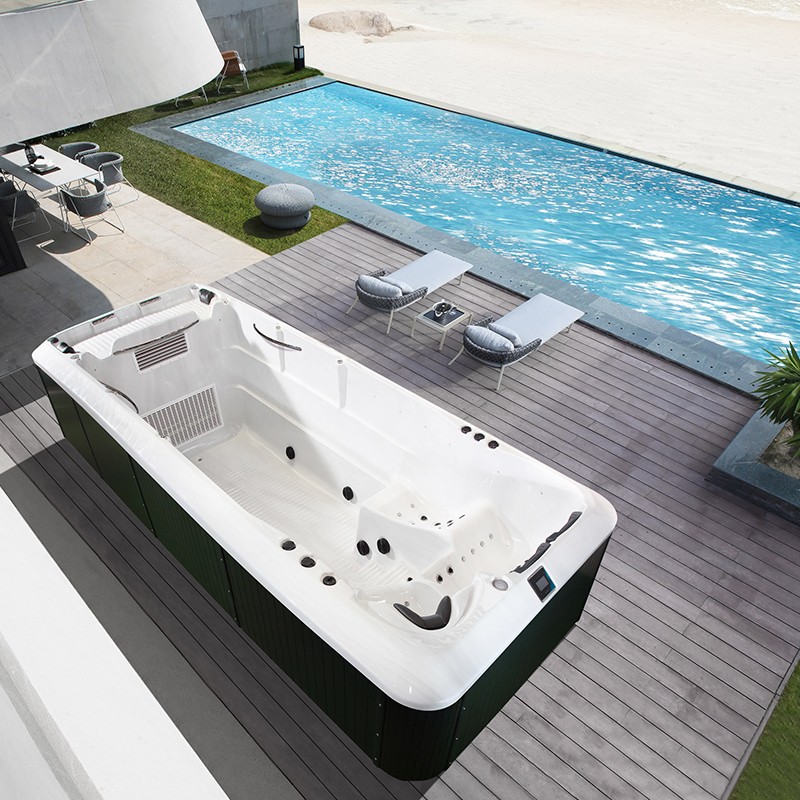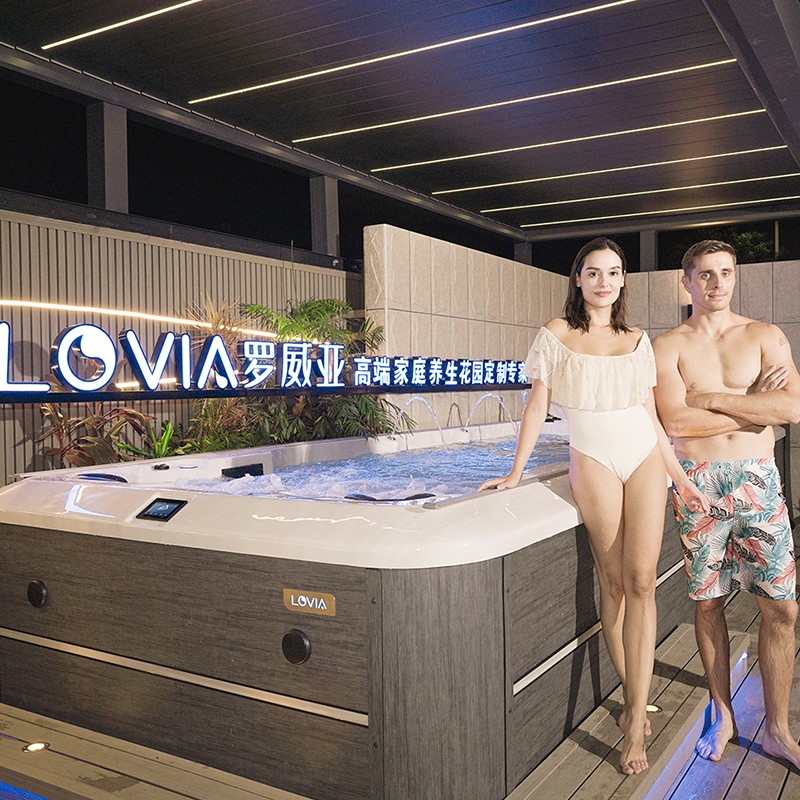
Will a swim spa tub freeze when used outdoors in winter?
2025-10-30 15:35With the diversification of home fitness and leisure activities, swim spa tubs have become an ideal choice for more and more people. They offer both constant-flow swimming training and relaxing hydrotherapy treatments, offering comprehensive functionality and a comfortable experience.
However, many users face a common winter question:
"If I install a swim spa tub outdoors in winter, will it freeze?"
After all, in low-temperature environments, any water-containing equipment is susceptible to damage due to ice formation.
This article will delve into this question from multiple perspectives, including structural design, heating systems, anti-freeze principles, usage instructions, and maintenance recommendations. This article will provide a clear understanding of why swim spa tubs can operate stably and safely even in the cold of winter.

Why is freezing a concern when using a swim spa tub outdoors in winter?
Before delving further, let's first understand why freezing is a potential risk for outdoor spa equipment.
1. Physical Changes of Water at Low Temperatures
When water temperature drops below 0°C, water molecules rearrange themselves into ice crystals, expanding in volume by approximately 9%.
If water is trapped inside equipment, such as pipes, nozzles, or filter chambers, the expanding ice can cause:
• Pipeline bursts;
• Damage to showerheads;
• Deformation of the heating system;
• Cracked pump seals.
Therefore, preventing water from freezing is the primary technical challenge for all outdoor water systems operating in winter.
2. Why are traditional swimming pools prone to freezing?
Traditional swimming pools are often open structures, contain large bodies of water, and lack continuous heating systems.
Once the ambient temperature remains below freezing for an extended period, surface water freezes rapidly, spreading to deeper areas.
Swim spa tubs are different because they offer the advantages of a closed system, active heating, and circulating insulation.

What anti-freeze features do swim spa tubs have?
Many people think of a swim spa tub as simply a large bathtub with flowing water, but its internal structure is far more complex than they imagine.
To accommodate year-round use, their design incorporates comprehensive winter anti-freeze technology.
1. Constant Temperature Heating System
Key to Preventing Water Temperatures from Subfreezing
Almost all high-quality swim spas are equipped with a constant temperature system.
Its main components include:
• Heater Unit: Maintains the set temperature through electrical heating or a heat pump;
• Temperature Sensor: Real-time water temperature monitoring;
• Automatic Circulation System: Ensures a continuous flow of hot water.
When the water temperature falls below a set threshold (such as 36°C or a user-defined temperature), the system automatically activates heating to prevent the water from dropping to freezing.
Thus, as long as the power remains connected, the water in the swim spa will not freeze.
2. High-Efficiency Insulation Structure
The outer shell of a swim spa typically utilizes a multi-layer insulation design, including:
• High-density polyurethane foam (PU foam): Coated around the outer layer to prevent heat loss;
• Insulation panels: Installed on the bottom and side walls to form an insulated cavity;
• Heat-reflective lining: Reduces heat loss through radiation.
This structure maintains stable heat within the tub in extremely low temperatures, maintaining a safe water temperature even in ambient temperatures as low as -15°C.
3. Circulation Pump and Nozzle Anti-freeze Mechanism
In a swim spa, water flow not only provides resistance to swimming but also serves as a freeze-proof circulation mechanism.
When the device detects a drop in ambient temperature, the control system automatically activates a low-speed circulation pump to keep water flowing through the pipes.
Because flowing water is less likely to freeze, this effectively prevents the nozzles and pump from freezing.

Is a swim spa truly ice-proof in extremely cold regions?
The answer is: with proper use and maintenance, it will not.
But to understand this conclusion, we need to delve deeper into the three principles of freeze protection.
1. Active Heating + Dynamic Circulation: Dual Protection
Standing water is more likely to freeze, while moving water disrupts the conditions for ice crystal formation.
A swim spa's heating and circulation systems work together to form a double freeze-proof barrier:
• The heating system maintains temperature;
• The circulation system prevents stagnant water from accumulating.
Even in extremely cold regions, as long as the power supply remains connected and the system operates automatically, the device provides long-term, stable freeze protection.
2. Intelligent Temperature Control and Monitoring System
Modern swim spas often have built-in intelligent temperature control modules that monitor water and ambient temperatures in real time.
Once the temperature is detected approaching freezing, the system automatically enters "freeze protection mode":
• Activates the circulation pump;
• Provides moderate heating;
• Disables unnecessary energy consumption.
This automatic protection mechanism ensures that the device is protected from low temperatures even when the user is away.
3. Structural Sealing and External Protection
The swim spa's cover and exterior are both exceptionally airtight.
The thick, thermally insulated cover effectively blocks cold air and reduces heat loss.
Replacing the cover promptly after use significantly enhances freeze protection.

Under what circumstances could a swim spa freeze?
Even though a swim spa has a comprehensive freeze protection system, there are still risks in the following special circumstances.
1. Power outage or prolonged power outage
All freeze protection features rely on electricity.
If the power is out for a prolonged period (over 24 hours) in severe cold weather, heating and circulation will cease, and stagnant water may begin to freeze.
Therefore, in winter, ensure:
• The tub is connected to a stable power source;
• It is equipped with an emergency power supply or freeze alarm system.
2. The tub is not covered or the cover is damaged
If the cover is damaged or not securely closed, cold air will come into direct contact with the water, significantly increasing the rate of heat loss.
It is recommended to regularly check the seal of the cover and replace the cover as necessary.
3. The tub is unused for extended periods of time and the automatic freeze protection mode is not enabled
If the user is away for extended periods of time without automatic circulation and heating enabled, accumulated water inside may gradually freeze in extremely low temperatures.
Therefore, the tub should be switched to "automatic freeze protection" or "low power constant temperature" mode before leaving home.
How does a swim spa's freeze protection system work?
To fully understand why a swim spa remains freeze-resistant, it is important to understand the operating logic of its freeze protection system.
1. Temperature Control Sensing Mechanism
Temperature sensors monitor water and air temperatures in real time.
When the temperature is detected approaching freezing (usually 5°C to 7°C), the system automatically activates the heater and water pump.
2. Intelligent Heating Logic
The heater maintains the water temperature at a preset lower limit (e.g., 35°C).
This continuous, micro-heating method not only prevents freezing but also maintains a constant water temperature, avoiding energy waste from frequent heating.
3. Anti-freeze Circulation Path
Water flows through the following sequentially:
• Pump;
• Filtration System;
• Jet Head and Spa Pipes;
• Return Channel.
This circulation ensures that there are no dead spots in the system, preventing freezing.
What precautions should be taken when using a swim spa in winter?
To ensure effective freeze protection and extend the life of the equipment, the following procedures should be followed during winter use.
1. Keep the power plugged in continuously
The swim spa's anti-freeze system requires electrical power.
Do not completely disconnect the power cord, even if it is not in use for a short period of time. You can set the device to low-temperature, energy-saving mode to keep it running smoothly on auto-cycle.
2. Secure the Insulated Cover
After each use, be sure to securely close the cover.
A high-quality insulation cover not only reduces heat loss but also prevents snow and rain from entering.
3. Check the Water Level Regularly
If the water level is too low, the pump may draw in air, causing the heater to dry out and affecting the freeze protection effect.
Thus, regularly refill the water to maintain a normal water level.
4. Clean the Filter System
A dirty filter reduces water flow efficiency and circulation speed, indirectly increasing the risk of freezing.
It is recommended to check the filter every two weeks during winter and clean or replace it if necessary.
If you don't plan to use your swim spa in winter, how should you store it to prevent freezing?
Some users in cold regions choose not to use it during the winter. In this case, take anti-freeze measures to drain the water.
1. Completely Drain the Water
• Open the drain valve;
• Run the circulation pump for several minutes to remove any remaining water;
• Remove the showerhead and wipe dry.
2. Use antifreeze to protect pipes
In extremely cold regions, inject a special, environmentally friendly antifreeze into the pipes to prevent residual water from freezing and damaging them.
Always use the type recommended by the manufacturer to avoid corrosion of seals.
3. Disconnect and cover
After draining, disconnect the power supply and cover with a heavy cover or waterproof cover to prevent snow, ice, and dust from entering.
What is the difference between a swim spa tub and a traditional swimming pool in terms of winter freeze protection?
From an engineering perspective, the difference is very clear:
Project | Swim spa tub | Traditional swimming pools |
| Heating system | Built-in automatic constant temperature system | Most lack constant temperature systems |
| Circulation system | Automatic low-speed anti-freeze cycle | Static water |
| Insulation structure | Multi-layer insulation and sealed cover | Open structure |
| Energy consumption control | Intelligent temperature control optimization | Requires manual intervention |
| Freezing risk | Extremely low | High temperature, prone to freezing |
| Maintenance complexity | Simple and automated | Requires manual cleaning and frost protection |
The conclusion is clear:
Swim spa tubs have a built-in freeze-resistant structure and active heating mechanism, while traditional swimming pools can only passively cope with low temperatures.
How can LOVIA SPA help distributors and retailers?
LOVIA SPA is a leading Chinese manufacturer and supplier of outdoor spas, swim spas, and hot tubs, providing comprehensive solutions for distributors and retailers worldwide. Our factory spans 45,000 square meters and employs over 200 workers and 20 experts who ensure every spa meets high-quality standards.
Retailers and distributors can request factory quotes, benefit from bulk purchasing, and enjoy promotional discounts. LOVIA SPA offers customizable spa options, including size, color, jet placement, and electrical systems. All products are certified with CE, ETL, SAA, ROHS, REACH, and ISO9001.
